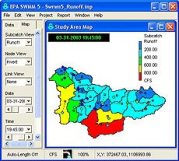

Research (free) tools
SWMM - Storm Water Management Model
Offered by: EPA – Unites States Environmental Protection Agency  '
'
Research tool description
SWMM - Storm Water Management Model
The Storm Water Management Model (SWMM) from EPA is used for planning, analysis and design related to:
• stormwater runoff,
• combined sewers,
• sanitary sewers,
• and other drainage systems in urban areas
• with many applications in non-urban areas as well.
This general purpose urban hydrology and conveyance system hydraulics software is a dynamic rainfall-runoff simulation model used for single event or long-term (continuous) simulation of runoff quantity and quality from primarily urban areas. The runoff component of SWMM operates on a collection of subcatchment areas that receive precipitation and generate runoff and pollutant loads. The routing portion of SWMM transports this runoff through:
• a system of pipes,
• channels,
• storage/treatment devices,
• pumps, and
• regulators.
Capabilities
SWMM accounts for various hydrologic processes that produce runoff from urban areas. These include:
• time-varying rainfall
• evaporation of standing surface water
• snow accumulation and melting
• rainfall interception from depression storage
• infiltration of rainfall into unsaturated soil layers
• percolation of infiltrated water into groundwater layers
• interflow between groundwater and the drainage system
• nonlinear reservoir routing of overland flow
• runoff reduction via Low Impact Development (LID) controls.
Applications
Since its inception, SWMM has been used in thousands of sewer and stormwater studies throughout the world. Typical applications include:
• design and sizing of drainage system components for flood control
• sizing of detention facilities and their appurtenances for flood control and water quality protection
• flood plain mapping of natural channel systems (SWMM 5 is a FEMA-approved model for NFPI studies)
• designing control strategies for minimizing combined sewer overflows
• evaluating the impact of inflow and infiltration on sanitary sewer overflows
• generating non-point source pollutant loadings for waste load allocation studies
• controlling site runoff using Low Impact Development practices
• evaluating the effectiveness of BMPs for reducing wet weather pollutant loadings.
Download program
Users manual
Applications manual
Source code files
More information (external link to the tool)
Sources of text, links and images: EPA – Unites States Environmental Protection Agency
Latest shared research tool
Statistical Software Package HEC-SSPThis software allows users to perform statistical analyses of hydrologic data. The current version of HEC-SSP can perform flo....